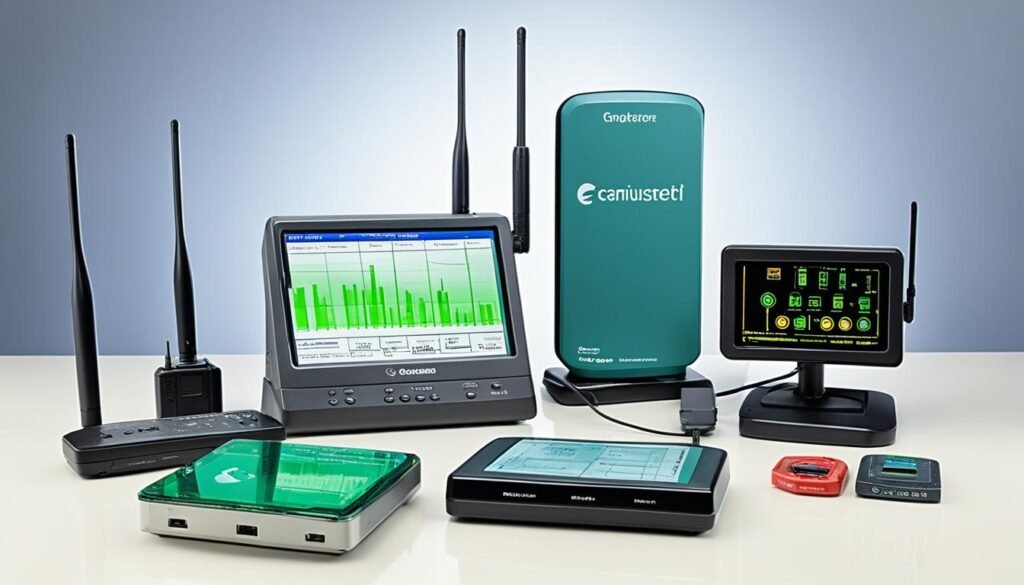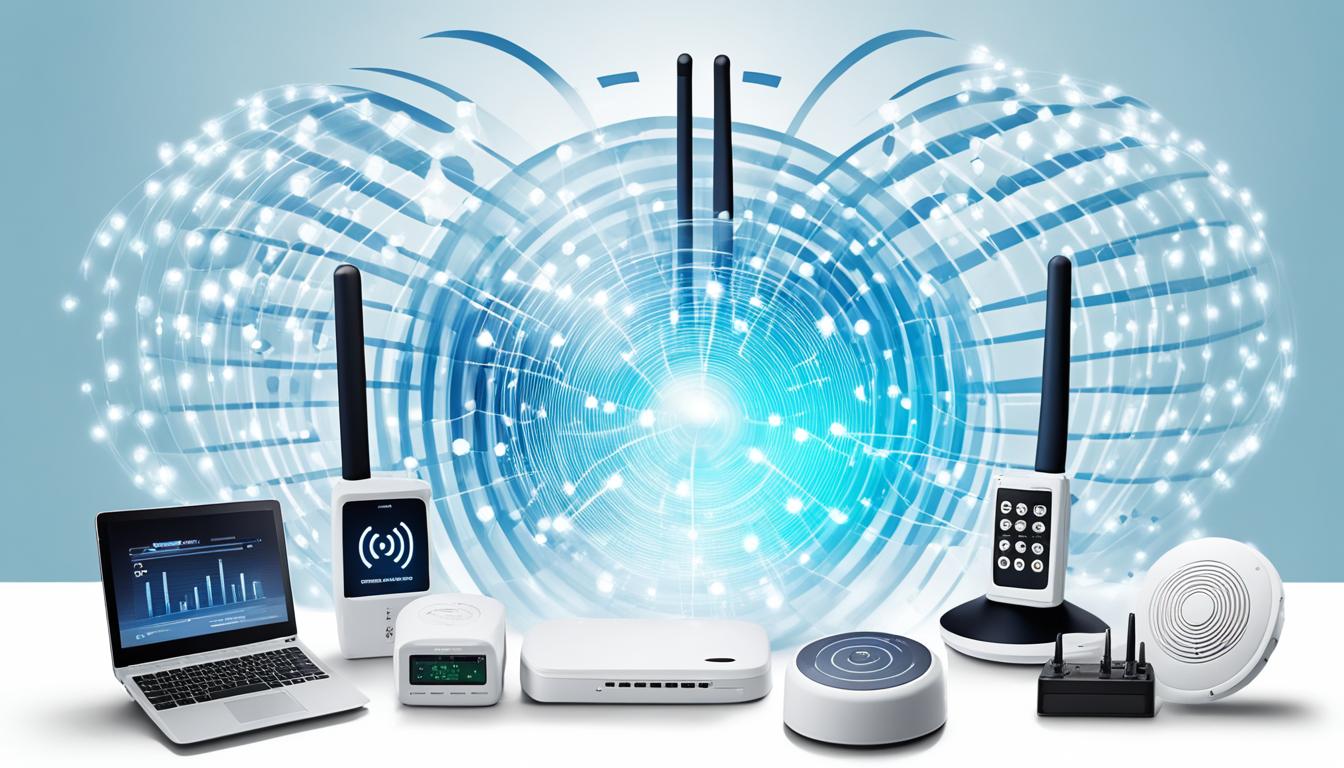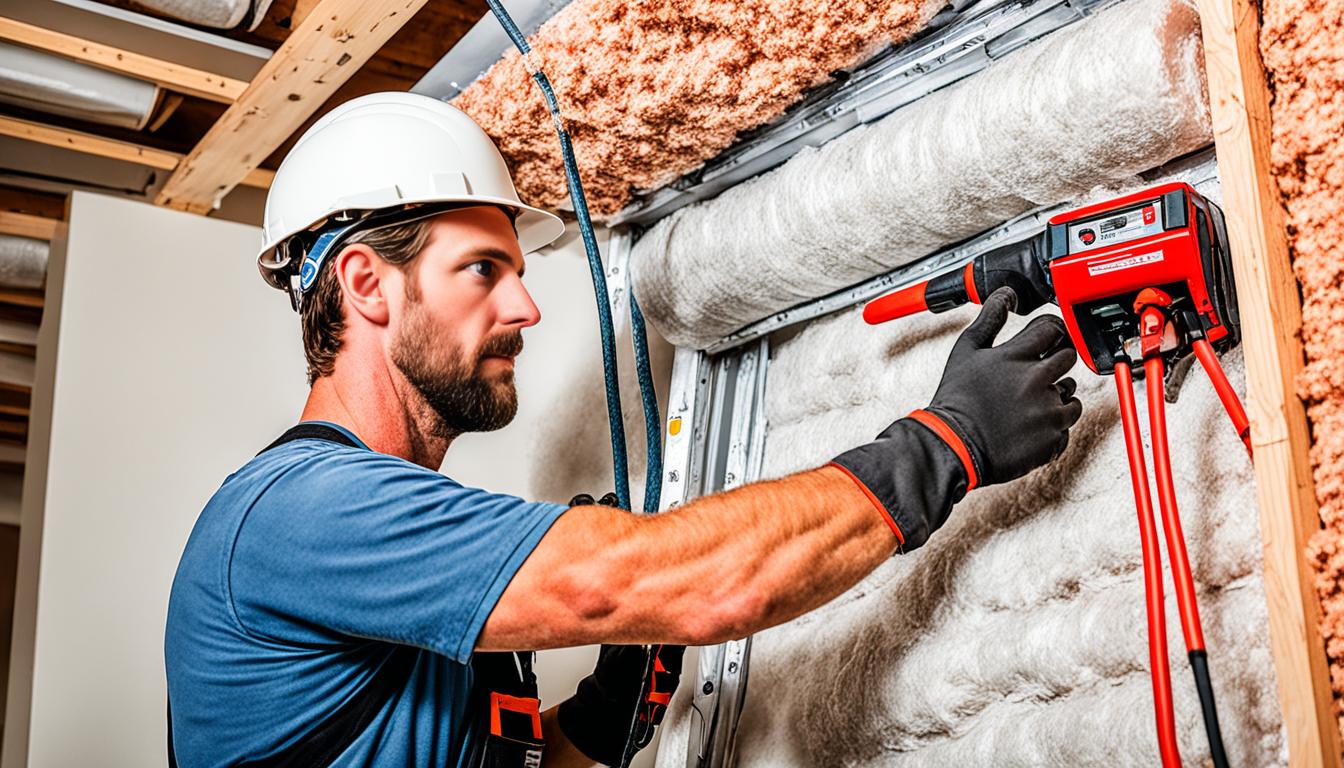Disclosure: This Post Contains Affiliate Links; We earn a commission on purchases.
Welcome to our guide on EMF safety guidelines for wireless networks! In today’s digitally connected world, Wi-Fi networks have become an essential part of our lives. However, it’s important to be aware of the potential health effects of electromagnetic radiation (EMF) emitted by wireless devices.
To ensure the well-being of ourselves and our loved ones, it’s crucial to follow certain tips and strategies for minimizing EMF exposure. By implementing these guidelines, you can create a safer wireless network environment and reduce the risks associated with EMF radiation.
Key Takeaways:
- Minimize your exposure to EMF radiation by increasing the distance from wireless devices.
- Identify and address the sources of wireless radiation in your home.
- Consider using airplane mode and corded landline phones to limit exposure.
- Reduce cell phone radiation exposure by using speakerphone or plug-in earpieces.
- Turn off wireless devices when not in use to minimize radiation emissions.
By following these guidelines and adopting safer alternatives, you can enjoy the benefits of wireless networks while prioritizing your health and well-being. Let’s explore these EMF safety tips in more detail in the following sections of this guide.
The Importance of Distance in Minimizing Exposure
When it comes to EMF safety guidelines for wireless networks, one of the most crucial factors to consider is the distance between ourselves and wireless devices. By increasing the distance, we can effectively minimize our exposure to electromagnetic radiation.
Research shows that the amount of wireless radiation absorbed by the body decreases rapidly as we move further away from the device. This is why it is important to keep cell phones, laptops, and other wireless devices at a distance from our bodies.
“The amount of wireless radiation absorbed by the body decreases exponentially as the distance from the device increases.”
To minimize exposure, consider the following wireless radiation safety measures:
- Use the speakerphone function or a plug-in earpiece to keep your cell phone away from your brain and body.
- Avoid carrying powered-off cell phones in pockets or bras.
- Keep wireless laptops on a desk or table rather than on your lap.
However, simply increasing the distance is just the first step in reducing your risk. The next step involves identifying safer ways to fulfill your connectivity needs without relying heavily on wireless radiation.
Identifying Sources of Wireless Radiation
In order to effectively prevent and minimize EMF exposure in wireless networks, it is crucial to identify the sources of wireless radiation in your home. By understanding which devices emit electromagnetic fields (EMF), you can take steps to address each source and find ways to reduce your exposure to their emissions.
Common devices that emit wireless radiation include:
- Computers
- Smart speakers
- Wi-Fi routers
- Gaming consoles
- Cordless phones
- Cordless mice
- Cell phones
- Wireless security systems
By being aware of these sources, you can begin the process of minimizing your exposure to wireless radiation step by step. This may involve finding alternative devices that emit less EMF, replacing certain devices with corded alternatives, or implementing strategies to limit your usage of wireless devices.
Identifying the sources of wireless radiation is an important first step towards creating a safer and healthier environment for yourself and your family.

Table 3: Common Sources of Wireless Radiation
| Device | EMF Radiation Emissions |
|---|---|
| Computers | Medium |
| Smart Speakers | Low |
| Wi-Fi Routers | High |
| Gaming Consoles | Medium |
| Cordless Phones | High |
| Cordless Mice | Medium |
| Cell Phones | High |
| Wireless Security Systems | Low |
Table 3 provides an overview of the common sources of wireless radiation and their corresponding levels of EMF emissions. It is important to note that these levels can vary depending on the specific model and usage of each device. Being informed about the potential EMF exposure of these devices can help guide your efforts to create a safer wireless network environment.
Airplane Mode and Corded Landline Phones
Airplane mode and corded landline phones provide safer alternatives to wireless devices. By implementing these measures, you can significantly reduce your exposure to electromagnetic fields (EMFs).
When you turn on airplane mode and disable Wi-Fi and Bluetooth on your cell phone, you effectively minimize the radiation emitted by the device. This is especially important when you are not using your phone for calls or data.
Corded landline phones, on the other hand, emit no wireless radiation at all. They use a physical connection to transmit voice conversations, making them a reliable and low-EMF option for communication. You can rely on corded landline phones for most voice conversations, ensuring minimal EMF exposure.
If a traditional copper landline is not available in your area, you can consider Voice over Internet Protocol (VoIP) systems or telephone line connections provided by internet service providers. These alternatives still utilize a wired connection, allowing you to enjoy the benefits of a corded phone without the need for a traditional landline.
By utilizing airplane mode and corded landline phones, you can not only reduce your exposure to EMFs but also ensure clear and reliable communication without compromising on safety. These simple steps can go a long way in protecting your health and well-being.
Minimizing Cell Phone Radiation Exposure
Minimizing cell phone use is crucial when it comes to reducing your overall radiation exposure. By implementing a few simple strategies, you can significantly lower the potential health risks associated with EMF radiation. Here are some practical tips to help you minimize cell phone radiation exposure:
- Use the speakerphone function or a plug-in earpiece: Keeping your phone away from your brain and body is essential. By utilizing the speakerphone function or using a plug-in earpiece, you can maintain a safe distance from the device.
- Power off your phone or set it on airplane mode: When you’re not actively using your cell phone, it’s recommended to power it off completely or place it on airplane mode with Wi-Fi and Bluetooth turned off. This eliminates the emission of wireless radiation.
- Opt for texting instead of voice calls: Texting requires less exposure to the phone compared to holding it to your ear during a voice call. Whenever possible, choose texting as a mode of communication to reduce radiation exposure.
- Keep your phone away from your body: Holding your phone away from your body when sending messages can help minimize radiation exposure to sensitive areas. Avoid carrying a powered-off cell phone in your pocket or bra, as it can still emit radiation.
Implementing these practices can go a long way in reducing your cell phone radiation exposure. Remember, every small step counts when it comes to protecting your health.
Quote:
“By minimizing cell phone use and adopting safer practices, individuals can take control of their exposure to radiation and safeguard their well-being.”

| Pros | Cons |
|---|---|
| Reduces cell phone radiation exposure | May require changes in communication habits |
| Increases awareness of potential health risks | Can be challenging to maintain consistently |
| Encourages safer and responsible cell phone usage | May take time to adjust to new habits |
Turning off Devices When Not in Use
One important safety measure to reduce exposure to wireless network radiation is turning off devices when they are not in use. Even when you are not actively using them, wireless devices continue to emit radiation as they constantly check in with the network. By turning off Wi-Fi and other wireless antennas, you can eliminate these emissions and minimize your exposure.
It’s essential to note that merely turning off Wi-Fi does not eliminate exposure when the Wi-Fi is turned on. The Wi-Fi signal is still present, and your devices may still be connected, even if you are not using them. To ensure minimal wireless exposure, it is recommended to turn off the Wi-Fi and unplug wireless devices when they are not in use.
Not only does turning off devices reduce your exposure to wireless radiation, but it also helps save energy. By unplugging devices, you can actively contribute to reducing your carbon footprint and create a more sustainable environment.
Take a moment to reflect on the devices in your home and consider which ones can be turned off or unplugged when not in use. Creating a habit of switching off wireless networks and devices is a simple yet impactful step towards reducing your wireless exposures.
Preferring Corded Technology Connections
Using corded connections instead of wireless technology is one of the most effective strategies for minimizing EMF exposure in wireless networks. By opting for corded connections, you can significantly reduce radiation emissions and promote a safer environment. Here are some key steps to implement corded technology connections:
- Connect home phones, internet devices, printers, speakers, and entertainment gear via cords or cables with all wireless features turned off. This ensures that these devices do not emit unnecessary radiation.
- Power off Wi-Fi internet connections during night-time to minimize continuous radiation exposure. Alternatively, consider using non-wireless modems for a safer internet connection.
- Choose gaming devices that offer the option to connect hand controllers with a cord. This reduces the reliance on wireless connections and decreases exposure to radiation.
- Use corded accessories such as printers, keyboards, mice, and speakers. These wired alternatives not only provide a more secure connection but also help reduce wireless radiation emissions.
By incorporating these corded technology connections into your wireless network setup, you can optimize EMF safety and minimize the potential health risks associated with prolonged exposure to electromagnetic radiation. Prioritizing corded connections fosters a healthier and safer environment for everyone.
Example of corded technology connections:
| Device | Wireless Connection | Corded Connection |
|---|---|---|
| Home Phone | Cordless phone | Corded landline phone |
| Internet | Wi-Fi | Ethernet cable |
| Printer | Wireless printing | USB cable |
| Speakers | Bluetooth | Auxiliary cable |
| Entertainment Gear | Wireless streaming | HDMI cable |
Conclusion
Implementing the EMF safety guidelines for wireless networks is essential to safeguard your health and minimize your exposure to electromagnetic radiation. By following these strategies, you can significantly reduce the health risks associated with EMF radiation.
Increasing the distance between yourself and wireless devices, identifying and addressing the sources of wireless radiation in your surroundings, and using airplane mode and corded landline phones are effective measures to minimize EMF exposure. Additionally, reducing cell phone radiation by minimizing usage, turning off devices when not in use, and preferring corded technology connections further decreases your exposure to EMF radiation.
These precautions are not only important for your well-being but particularly crucial for vulnerable individuals such as children, pregnant women, and those who work with electronic equipment or frequently use wireless devices. By implementing these EMF safety guidelines, you can protect your health and enjoy the benefits of wireless technology with reduced risks from EMF EMR.
Source Links
- https://ehtrust.org/educate-yourself/ten-steps-to-safe-tech/
- https://www.epa.ie/environment-and-you/radiation/emf/emf-and-your-health/wifi-and-your-health/
- https://www.amymyersmd.com/article/wifi-emf-emr

Subscribe to Our Newsletter










